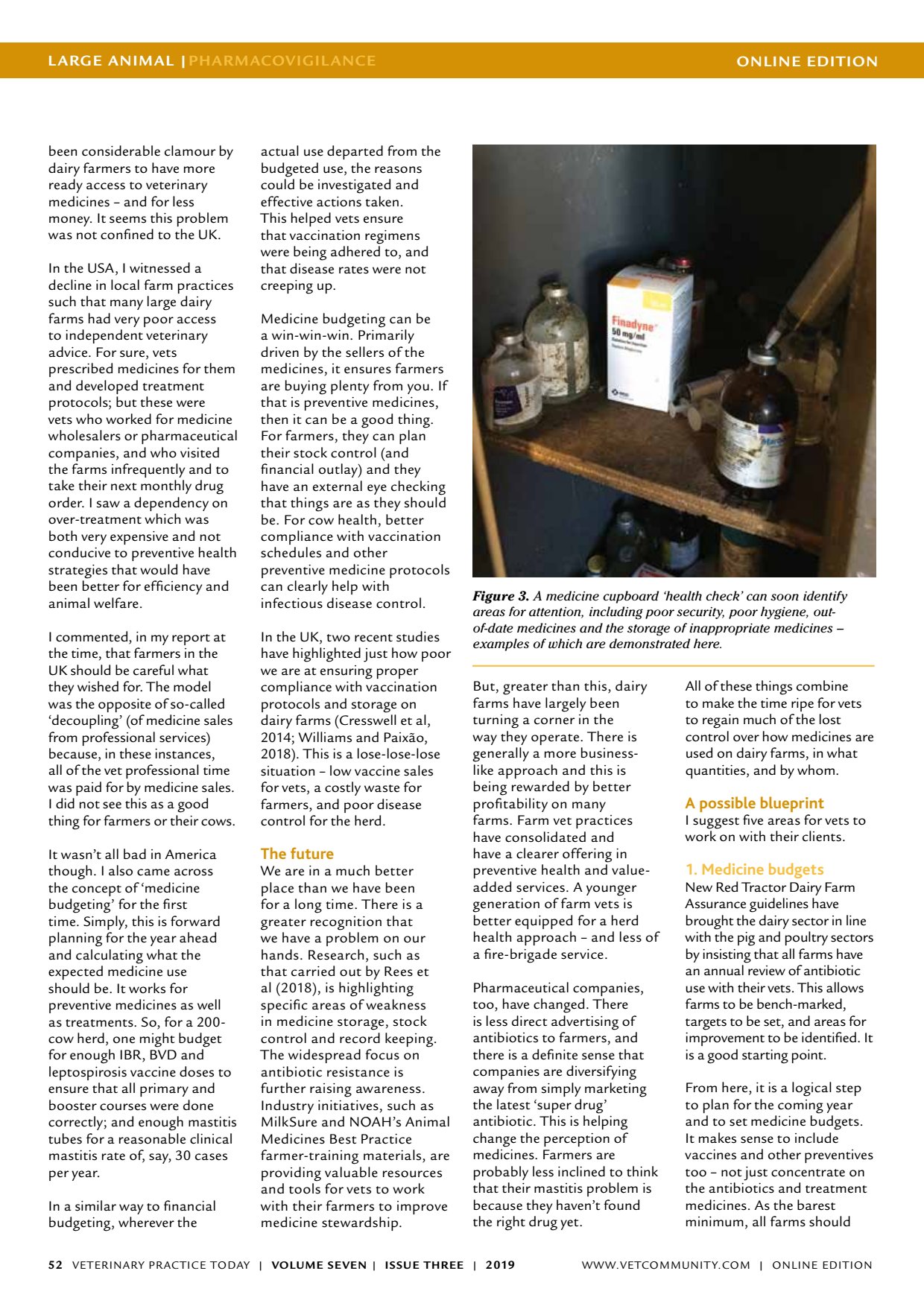future possible blueprint
ONLINE EDITION VETERINARY PRACTICE TODAY | VOLUME SEVEN | ISSUE THREE | 2019 52 L ARGE ANIMAL |PHARMACOVIGIL ANCE been considerable clamour by dairy farmers to have more ready access to veterinary medicines and for less money. It seems this problem was not confined to the UK. In the USA, I witnessed a decline in local farm practices such that many large dairy farms had very poor access to independent veterinary advice. For sure, vets prescribed medicines for them and developed treatment protocols; but these were vets who worked for medicine wholesalers or pharmaceutical companies, and who visited the farms infrequently and to take their next monthly drug order. I saw a dependency on over-treatment which was both very expensive and not conducive to preventive health strategies that would have been better for efficiency and animal welfare. I commented, in my report at the time, that farmers in the UK should be careful what they wished for. The model was the opposite of so-called decoupling (of medicine sales from professional services) because, in these instances, all of the vet professional time was paid for by medicine sales. I did not see this as a good thing for farmers or their cows. It wasnt all bad in America though. I also came across the concept of medicine budgeting for the first time. Simply, this is forward planning for the year ahead and calculating what the expected medicine use should be. It works for preventive medicines as well as treatments. So, for a 200- cow herd, one might budget for enough IBR, BVD and leptospirosis vaccine doses to ensure that all primary and booster courses were done correctly; and enough mastitis tubes for a reasonable clinical mastitis rate of, say, 30 cases per year. In a similar way to financial budgeting, wherever the actual use departed from the budgeted use, the reasons could be investigated and effective actions taken. This helped vets ensure that vaccination regimens were being adhered to, and that disease rates were not creeping up. Medicine budgeting can be a win-win-win. Primarily driven by the sellers of the medicines, it ensures farmers are buying plenty from you. If that is preventive medicines, then it can be a good thing. For farmers, they can plan their stock control (and financial outlay) and they have an external eye checking that things are as they should be. For cow health, better compliance with vaccination schedules and other preventive medicine protocols can clearly help with infectious disease control. In the UK, two recent studies have highlighted just how poor we are at ensuring proper compliance with vaccination protocols and storage on dairy farms (Cresswell et al, 2014; Williams and Paixão, 2018). This is a lose-lose-lose situation low vaccine sales for vets, a costly waste for farmers, and poor disease control for the herd. The future We are in a much better place than we have been for a long time. There is a greater recognition that we have a problem on our hands. Research, such as that carried out by Rees et al (2018), is highlighting specific areas of weakness in medicine storage, stock control and record keeping. The widespread focus on antibiotic resistance is further raising awareness. Industry initiatives, such as MilkSure and NOAHs Animal Medicines Best Practice farmer-training materials, are providing valuable resources and tools for vets to work with their farmers to improve medicine stewardship. But, greater than this, dairy farms have largely been turning a corner in the way they operate. There is generally a more business- like approach and this is being rewarded by better profitability on many farms. Farm vet practices have consolidated and have a clearer offering in preventive health and value- added services. A younger generation of farm vets is better equipped for a herd health approach and less of a fire-brigade service. Pharmaceutical companies, too, have changed. There is less direct advertising of antibiotics to farmers, and there is a definite sense that companies are diversifying away from simply marketing the latest super drug antibiotic. This is helping change the perception of medicines. Farmers are probably less inclined to think that their mastitis problem is because they havent found the right drug yet. All of these things combine to make the time ripe for vets to regain much of the lost control over how medicines are used on dairy farms, in what quantities, and by whom. A possible blueprint I suggest five areas for vets to work on with their clients. 1. Medicine budgets New Red Tractor Dairy Farm Assurance guidelines have brought the dairy sector in line with the pig and poultry sectors by insisting that all farms have an annual review of antibiotic use with their vets. This allows farms to be bench-marked, targets to be set, and areas for improvement to be identified. It is a good starting point. From here, it is a logical step to plan for the coming year and to set medicine budgets. It makes sense to include vaccines and other preventives too not just concentrate on the antibiotics and treatment medicines. As the barest minimum, all farms should Figure 3. A medicine cupboard health check can soon identify areas for attention, including poor security, poor hygiene, out- of-date medicines and the storage of inappropriate medicines examples of which are demonstrated here. WWW.VETCOMMUNIT Y.COM | ONLINE EDITION
